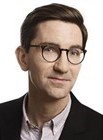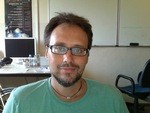Events - Page 31
Michael Whittaker from University of Glasgow will give a talk with title: New directions in self-similar group theory
Abstract: A self-similar group (G,X) consists of a group G acting faithfully on a homogeneous rooted tree such that the action satisfies a self-similar condition. In this talk I will generalise the above definition to faithful groupoid actions on the path space of more general graphs. This new definition allows us to work out the structure of the KMS state space of associated Toeplitz and Cuntz-Pimsner algebras. This is joint work with Marcelo Laca, Iain Raeburn, and Jacqui Ramagge.
Rasmus Bryder (University of Copenhagen) will give a talk with title: Twisted crossed products over C*-simple groups
Abstract: A twisted C*-dynamical system consists of a C*-algebra, a discrete group and a "twisted" action of the group on the C*-algebra, i.e., the group acts by automorphisms on the C*-algebra in a manner determined by a 2-cocycle of the group into the unitary group of the C*-algebra. Whenever the 2-cocycle (or twist) is trivial, the action is given by a group homomorphism of the group into the automorphism group of the C*-algebra. We consider twisted C*-dynamical systems over C*-simple groups (i.e.,groups whose reduced group C*-algebra is simple) and how C*-simplicity affects the ideal structure of reduced crossed products over such dynamical systems.
Microfluidics of sugar transport in plants
Plants can rightly be called masters of microengineering. Their survival and successful reproduction depends on their ability to overcome a series of physical challenges during growth and when transporting matter over great distances. In this talk, we focus on the microfluidic network responsible for energy distribution (the phloem). We combine experiments on living plants and biomimetic microfluidic devices to elucidate the basic physical principles that govern sugar transport in plants. We derive a scaling relation between the characteristic sizes of the plant organs, which optimizes the rate of sugar transport. Comparison with experimental data suggests that the pipe network is operating at or near the theoretical optimum. We further consider the coupling between photosynthesis and long-distance transport. While sap with high sugar concentration has the greatest transport potential, viscosity impedes flow, a phenomena analogous to congestion in traffic flows. The optimal sugar concentration for transport in plants is 25%, sweeter than Coke (10%) but much less viscous than maple syrup (65%). Although plants have generally evolved towards the theoretical optimum, a number of unusually sweet plants exist. This group consists primarily of crop plants such as corn (40%) and potato (50%), sugar junkies of the natural world.
Prof Per Mykland (University of Chicago) will give a seminar in the lunch area, 8th floor Niels Henrik Abels hus at 14:15.
In this talk I will explain how the use of functors defined on the category I of finite sets and injections makes it possible to replace E-infinity objects by strictly commutative ones. For example, an E-infinity space can be replaced by a strictly commutative monoid in I-diagrams of spaces. The quasi-categorical version of this result is one building block for an interesting rigidification result about multiplicative homotopy theories: we show that every presentably symmetric monoidal infinity-category is represented by a symmetric monoidal model category. (This is based on joint work with C. Schlichtkrull, with D. Kodjabachev, and with T. Nikolaus)
Given a Nisnevich sheaf (on smooth schemes of finite type) of spectra, there exists a universal process of making it 𝔸1-invariant, called 𝔸1-localization. Unfortunately, this is not a stalkwise process and the property of being stalkwise a connective spectrum may be destroyed. However, the 𝔸1-connectivity theorem of Morel shows that this is not the case when working over a field. We report on joint work with Johannes Schmidt and sketch our approach towards the following theorem: Over a Dedekind scheme with infinite residue fields, 𝔸1-localization decreases the stalkwise connectivity by at most one. As in Morel’s case, we use a strong geometric input which is a Nisnevich-local version of Gabber’s geometric presentation result over a henselian discrete valuation ring with infinite residue field.
The advances on the Milnor- and Bloch-Kato conjectures have led to a good understanding of motivic cohomology and algebraic K-theory with finite coefficients. However, important questions remain about rational motivic cohomology and algebraic K-theory, including the Beilinson-Soulé vanishing conjecture. We discuss how the speaker's "connectivity conjecture" for the stable rank filtration of algebraic K-theory leads to the construction of chain complexes whose cohomology groups may compute rational motivic cohomology, and simultaneously satisfy the vanishing conjecture. These "rank complexes" serve a similar purpose as Goncharov's candidates for motivic complexes, but have the advantage that they have a precise relation to rational algebraic K-theory.
The so-called Koras-Russell threefolds are a family of topologically
contractible rational smooth complex affine threefolds which played an
important role in the linearization problem for multiplicative group
actions on the affine 3-space. They are known to be all diffeomorphic to
the 6-dimensional Euclidean space, but it was shown by Makar-Limanov in
the nineties that none of them are algebraically isomorphic to the affine
3-space. It is however not known whether they are stably isomorphic or not
to an affine space. Recently, Hoyois, Krishna and Østvær proved that many
of these varieties become contractible in the unstable A^1-homotopy
category of Morel and Voevodsky after some finite suspension with the
pointed projective line. In this talk, I will explain how additional
geometric properties related to additive group actions on such varieties
allow to conclude that a large class of them are actually A^1-contractible
(Joint work with Jean Fasel, Université Grenoble-Alpes).
Digital signalbehandling og bildeanalyse, UiO and PGS
The effects of moving rough sea surfaces on seismic data.
Andreas Andersson (UiO): An introduction to duality for compact groups in algebraic quantum field theory
Tamara Broderick (Massachusetts Institute of Technology) will give a seminar in the lunch area, 8th floor Niels Henrik Abels hus at 14:15.
In this talk, we will present some applications of the "transfer" to
algebraic K-theory, inspired by the work of Thomason. Let A --> B be a
G-Galois extension of rings, or more generally of E-infinity ring spectra
in the sense of Rognes. A basic question in algebraic K-theory asks how
close the map K(A) --> K(B)^hG is to being an equivalence, i.e., how close
K is to satisfying Galois descent. Motivated by the classical descent
theorem of Thomason, one also expects such a result after "periodic"
localization. We formulate and prove a general lemma that enables one to
translate rational descent statements as above into descent statements
after telescopic localization. As a result, we prove various descent
results in the telescopically localized K-theory, TC, etc. of ring
spectra, and verify several cases of a conjecture of Ausoni-Rognes. This
is joint work with Dustin Clausen, Niko Naumann, and Justin Noel.
The Bass-Quillen conjecture states that every vector bundle over A^n_R is
extended from Spec(R) for a regular noetherian ring R. In 1981, Lindel
proved that this conjecture has an affirmative solution when R is
essentially of finite type over a field. We will discuss an equivariant
version of this conjecture for the action of a reductive group. When R =
C, this is called the equivariant Serre problem and has been studied by
authors like Knop, Kraft-Schwarz, Masuda-Moser-Jauslin-Petrie. In this
talk, we will be interested in the case when R is a more general regular
ring. This is based on joint work with Amalendu Krishna
Enrico Fermi and the birth of modern nonlinear physics
In the early fifties in Los Alamos E. Fermi in collaboration with J. Pasta and S. Ulam investigated a one dimensional chain of equal masses connected by a weakly nonlinear spring. The key question was related to the understanding of the phenomenon of conduction in solids; in particular they wanted to estimate the time needed to reach a statistical equilibrium state characterized by the equipartition of energy among the Fourier modes. They approached the problem numerically using the MANIAC I computer; however, the system did not thermailize and they observed a recurrence to the initial state (this is known as the FPU-recurrence). This unexpected result has led to the development of the modern nonlinear physics (discovery of solitons and integrability). In this seminar, I will give an historical overview of the subject and present the different approaches that have been proposed in the last 60 years for explaining this paradox. Very recent results on the estimation of the time scale and on the explanation of the mechanism of equipartition will also be discussed.
In Part 2 we will delve into the worlds of derived and spectral algebraic
geometry. After reviewing some basic notions we will explain how motivic
homotopy theory can be extended to these settings. As far as time permits
we will then discuss applications to virtual fundamental classes, as well
as a new cohomology theory for commutative ring spectra, a brave new
analogue of Weibel's KH
In Part 2 we will delve into the worlds of derived and spectral algebraic
geometry. After reviewing some basic notions we will explain how motivic
homotopy theory can be extended to these settings. As far as time permits
we will then discuss applications to virtual fundamental classes, as well
as a new cohomology theory for commutative ring spectra, a brave new
analogue of Weibel's KH
We consider extensions of Morel-Voevodsky's motivic homotopy theory to the
settings of derived and spectral algebraic geometry. Part I will be a
review of the language of infinity-categories and the setup of
Morel-Voevodsky homotopy theory in this language. As an example we will
sketch an infinity-categorical proof of the representability of Weibel's
homotopy invariant K-theory in the motivic homotopy category.
Numerical methods for stochastic conservation laws
Experimental investigation of linear stability mechanisms in stratified gas-liquid pipe flow
The evolution of interfacial waves on a stratified air water pipe flow is investigated experimentally. An oscillating plate introduced controlled perturbations at the inlet of the pipe. High speed cameras captured the evolution of these perturbations along the pipe by means of a phase-locked shadowgraphy technique. Thereby, it was possible to measure the temporal and the spatial evolution of the disturbances introduced in the flow. Particle image velocimetry was performed further downstream in order to evaluate changes in the base flow.
A relatively large data bank has been gathered with varying air and water flow rates as well as varying amplitudes and frequencies of the inlet perturbations. Some preliminary results contain a qualitative assessment of linear vs. non-linear regimes and momentum transfer into the water layer.
Yuan Wang (Utah), gives the Seminar in Algebra and Algebraic Geometry:
"On the characterization of abelian varieties for log pairs in zero and positive characteristic"
Håvard Kvamme (UiO, Dept. of mathematics) will give a seminar in the lunch area, 8th floor Niels Henrik Abels hus at 14:15.
We will discuss the motivic May spectral sequence and demonstrate how to use it to identify Massey products in the motivic Adams spectral sequence. We will then investigate what is known about the motivic homotopy groups of the eta-local sphere over the complex numbers and discuss how these calculations may work over other base fields.

